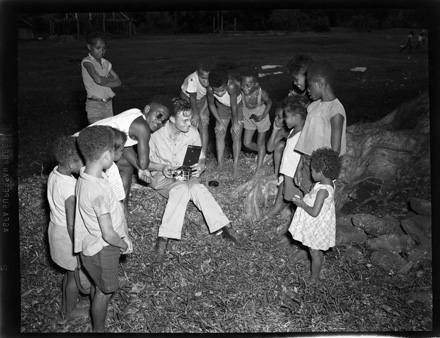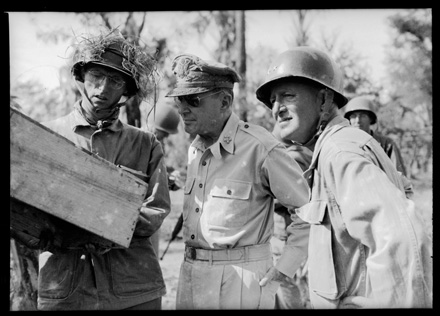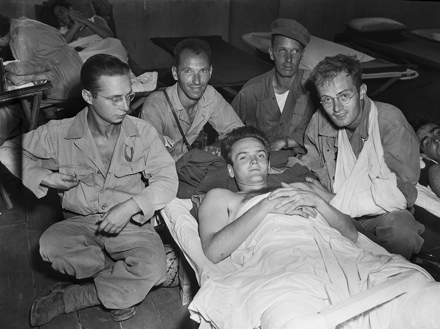Memorial Day seems a most appropriate occasion to highlight some of the images documenting Hugh Morton’s World War II experiences. The broad strokes of the story are well known: aware that he would end up in the military and hoping to receive an assignment in photography, Morton enlisted in October 1942 and was first posted at the U.S. Army Anti-Aircraft School at Camp Davis, taking pictures for training manuals.
When he was sent to New Caledonia to report to the 161st Army Signal Corps Photo Company, he was surprised when his captain looked at him and said, “Morton, you look like a movie man.” (This was the first time he picked up a movie camera, but it certainly wouldn’t be the last—future blog posts will explore some of Morton’s later adventures in filmmaking). Since his wartime film footage went directly to the Army, we don’t have any of it in the collection here at UNC—but we do have a small number of still images taken by and of Morton during these eventful years.
Here’s Morton, in a photo by an unknown photographer, with his movie camera atop a B-24, the “Go Gettin’ Gal“:
In 1944 Morton obtained an enjoyable assignment covering Bob Hope, Frances Langford, and Jerry Colonna as they entertained the troops at New Caledonia. In the booklet Sixty Years with a Camera, Morton described these as “three of the happiest days of my life…I rode in the same car with Bob and Jerry…during which they were cracking jokes and practicing their lines. It was a fun time.”
From there, he was sent briefly to Guadalcanal and Bougainville, which may be when the following images were snapped (the first is by Morton; the second shows Morton with his camera and a group of Pacific island children, taken by an unknown photographer):
Morton then got his most intense assignment when he was sent to photograph the 25th Infantry Division as they invaded Luzon, in the Philippines, in early 1945. He obtained a few still shots of combat, and covered General Douglas MacArthur when he came to Luzon to inspect the 25th Division:
Shortly after MacArthur’s visit, Morton was wounded in an explosion—an incident for which he received a Purple Heart and Bronze Star, with citation, for exposing himself to danger in order to obtain high-quality, closeup images of the front lines. Morton recounts the incident in UNC-TV’s “Biographical Conversations” (video available online), claiming that the Speed Graphic camera he held in front of his face helped save him from further injury.
A note of interest: the Library of Congress holds the papers and photos of another member of the 161st Photographic Company, Charles Rosario Restifo. Be sure to check out Restifo’s detailed autobiography, wherein he discusses his training, camp life, and experiences in the Pacific, many of which would have been similar to or the same as Morton’s. I don’t believe Restifo is in the picture above, and he doesn’t mention Morton by name in the memoir, but it sounds like they were on many of the same assignments—in fact, if you look on page 98 of Restifo’s book, the image of MacArthur appears to be the exact same image as Morton’s (above)! Not just similar, but identical. Not sure how this happened.
One last Memorial Day musing: Morton didn’t leave his WW2 experiences behind him when he left the Pacific. As I discussed in a previous blog post, he deserves a lot of credit for the establishment of the USS North Carolina as a memorial to North Carolinians who died in WW2 service.


![Frances Langford and Bob Hope entertaining military personnel in New Caledonia, 1944 [cropped]](https://blogs.lib.unc.edu/morton/wp-content/uploads/sites/7/2008/05/p081_ntbf4_000136_04.jpg)




Elizabeth: FYI:
There is also a fascinating account of Hugh Morton’s wartime experience in the December 2, 1950 issue of “The State” Magazine starting on page 4. The title of Bill Sharpe’s article is “Photo By Morton,” and it’s a mini-biography and tells how he was injured during WWII.
I also recall Hugh adding a footnote to the story one time when he was doing a slide presentation. He said following his time in an army hospital, he was given some leave time and returned to Wilmington. One day, as he was walking down the main street of the port city, he noticed on the theater marquee something like “see the latest World War II newsreels.” So he went inside, and when the newsreel film came up on the screen, it was the film he had shot the morning of his injury.
Also, in that same article. there is some information about Joe Hartley and “Singing On The Mountain’s” early days. That would relate to your blog of March 11th about “Happy John.”
Yes, I referred to that article when writing the post, but thanks for letting others know about it, Jack. Now that I’ve realized what a treasure trove “The State” is (thanks to you), I’m using it a lot…
Elizabeth: One more comment about Hugh Morton’s wartime photographs. In the October 1, 1968 issue of the “State” magazine, Hugh lists his favorite 10 photographs. One of the favorites is a photo taken in the mountains of Luzon. Ironically, the photograph was taken on the day he was wounded. The photograph is on page 11.
Isn’t that an amazing story of his captain telling him he looked like a movie man. That’s why I believe that some people are just destined to do certain things. It’s a God thing, has to be. That’s just such an odd thing to say to someone to just be casually innocent.
What a great piece on Hugh Morton and his time serving during WWII. I just recently videotaped my Dad for the Library of Congress Veteran’s History Project. This was full of his remembrances of the time:what it was like to travel around the States; how embarrassed he was (before the enlisted in the Navy) to be working in a Hane’s Knitting plant and not be serving; etc. My Dad has photos too-but they are mostly of aircraft since he served in an aerial intelligence unit teaching Navy fliers how to recognize OUR aircraft and not shoot them down accidentally. The Morton photographs are excellent and amazing. thanks for sharing this.
My father served in WWII but wouldn’t talk about it. Because of his experience he was very against me going into any type of military. I think war is necessary sometimes, but I dread what it does to people.
hi, i’m mann andd i’m from the philippines. i’ve been looking for my granddad jack paul welch. i have very liitle information on him though, since grandmom pacita is now 83. one thing she and folks here are certain about, is that he wore all-white uniform. i guess that indicates he was with the navy and was stationed in the philippines.
he and grandmom met on a barge from cagayan de oro ( a province in the philippines ) to mambajao, camiguin island, misamis oriental in 1945. they say he stayed at the neri’s, which was across the camiguin institute then, and that he was always with two other officers, john and leonard or lenard.
folks say one time, he took them to catarman, on a jeep with father polloct.
grandmom gave birth to my father nelson in august 1946. according to grandmom, in granddad’s last letter, he wrote north carolina as his address.
unfortunately, these letters and other things that could’ve made this search easy, were all gone when the volcano ( mt. hibok-hibok ) erupted. besides, grandpa joe, my grandmom’s father, never approved of the relationship since it started, because grandmom was only 15 during that time. he kept all the letters from her. it was only when the last letter came, where granddad paul asked grandmom if she was pregnant, that grandpa allowed her to read. he told her to write him back and say she got pregnant and gave birth to a girl, but the baby died.
from that time on, no letters were received from granddad paul ever again.
i’m hoping someone can help me, please. dad’s already 62 and still searching. i wanna end his longing,he has never seen his father eversince. if granddad paul has already gone to rest, then maybe someone can at least tell us where so we can pay our respect to him. to his family, please give us this chance. to those who get to read this, please, if there’s anything or anyone you know might be of help,please let us know. we would appreciate it so much. and if he still lives, granddad paul, we want you to know that somewhere in the far philippines, you are so longed for and so loved.
thank you for the time.
mann
The picture of Hugh (arm in a sling ) and Conway “Rosebud” Spanton (in bed ) was made in a field hospital in the Philippines in March of ’45. “Rosebud” was the still man in the team in which Hugh was the movie man. They were not wounded at the same time, but were together at the hospital. Hugh had the unusual experience of finding himself in a bed beside a wounded “war-dog” (O.K., a member of the Canine Corps.) Had the dog’s handled not been wounded in the same action as the dog (breaking up an ambush) the dog would probably have had to be destroyed. As it was, they were able to care for both the heroes by letting them stay together. Hugh said everyone was so focused on the dog that none of the rest of the patients got much attention, but no one minded. “Rosebud” eventually chose to have his damaged leg amputated because it never stopped hurting. He was elected judge in his home state (Ohio, I think) and came to see us once in Wilmington. A likeable guy.
Hugh tried to send quite a few pictures to his parents from the Pacific but many never made it. The only solution that he came up for this was that the officer censoring his letters must have liked them, too. He really did take that picture of the Generals, if you have any doubt. (I can’t imagine you do.) He didn’t get to keep his photos, after all; they belonged to the Army. We saw one picture he took (a still and almost a silhouett)of a GI against the rising sun walking along carrying a rifle. He said he woke up in his fox hole that morning and saw the men moving out, he liked what he saw and made a photo of the scene. The Army used it in an ad, which is where he saw it later. Many of his pictures weren’t movies.
Hugh told me he never saw anyone overseas whom he knew but once. He had been assigned to photograph Army equipment being loaded onto ships for the invasion of the Philippines, had finished, and was packing up his camera gear when a shiny Navy ensign came up to him and asked, “Hey, Soldier, what are you doing?” They ultimately ended up cooling their heels outside the Captain’s office till Hugh could clear himself of espionage charges or whatever. When they were finally ushered into the Captain’s office the gentleman looked up from his desk and said, “Well, Hugh Morton! What in the hell are you doing here?” The ensign (a novice, but not stupid ) vanished, Hugh and Captain Poppum (sp?) spoke briefly and Hugh went on his way. The Captain had been the head of the NROTC training unit at Chapel Hill and Hugh had photographed him and the students enrolled in that program many times.
hi, i’m mann. i’m hoping someone can help me with my search for mr. jack paul welch. he was in the army during ww2, a military police. i’ve been searching for him. please… if anybody has a photo of him or knows his whereabouts, i’ll truly appreciate your help.
thank you…
hoping,
mann
Regarding Charles R Restifo and the duplicate photo of MacArthur. It would be the same photo and either Restifo or Morton could have taken it.
My father was also in the Signal Photo Corps. He was part of a mobile lab that moved from Tacloban to Manila. Charles Restifo was in charge of another mobile photo lab.
The two labs met up and combined in Manila, in a permanent facility the Sampugita Pictures office. It was the only one on the island, and all the photographers (including Morton) would have used it to process their images. My father said the photographers often traded pictures, and the lab techs would make duplicates of ones they wanted as souvenirs. Restifo also mentions this with regard to the famous photo of MacArthur signing the surrender papers. There was only one lab in Tokyo too.)
Two photos in Restifo’s collection are also in my father’s.
Here’s a primary source that explains it all:
http://pacificwarphotos.com/background/mobile-photo-lab-history/
And my commentary on it:
http://pacificwarphotos.com/background/other-members/
Hope you find this useful!
Debra, thanks for this great information and for creating a fantastic web resource on the Pacific War.
Could this Morton image depict the lab and/or some of the staff you refer to?
I suggest you look through all of Morton’s WW2 photos to see if there’s anything or anyone you recognize.
A photograph of the airplane “Go Gettin’ Gal” is in the Thomas L. Wood Photograph Collection at the United States Army Military History Institute. An unidentified person stands next to the plane. Perhaps it’s the pilot? The negative is in a box label “Film N.C.” (New Caledonia) and dates from October 1944.